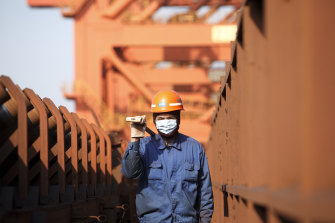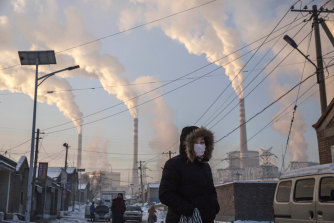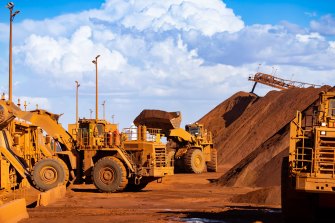A perfect storm is brewing for Australia’s iron ore miners
For our free coronavirus pandemic coverage, learn more here.
A near-perfect storm has hit the market for iron ore, forcing the price down more than 30 per cent from its May peak amid a confluence of China-centric developments. Some of those influences are transitory but others will have lasting effects on demand for Australia’s most valuable commodity.
The price, which started the year just below $US160 a tonne, peaked at just over $US230 a tonne against the backdrop of a boom in China’s steel production.
China is trying to restructure its economy and reshape it to deleverage and to reduce the rate of growth in its carbon emissions, lowering demand for iron ore.Credit:Getty
After record production of 1.05 million tonnes last year, production for the first half of this year was running almost 12 per cent higher before something – or several somethings – happened and the price cracked. It’s now back below $US160 a tonne.
At a macro level China’s economy has been slowing amid a renewed effort by the authorities to reduce leverage, particularly in the over-indebted property and construction sectors where some of the country’s biggest companies are teetering. Those sectors are the biggest sources of demand for steel.
The slowdown is, however, broadly-based. Recent data shows industrial production, retail sales, investment and even employment are falling short of expectations.
The authorities have revealed their concern by relaxing reserve requirements for their banks and pumping liquidity into their financial system to improve access to credit and put a safety net under growth.
That’s a near-term challenge but one overlaid by a long-term objective that will also impact growth and demand for commodities, particularly iron ore.
China, which produces nearly a third of global carbon emissions, has committed itself to achieving peak emissions by 2030 (and net zero by 2060). With its steel sector producing about 15 per cent of those emissions, it’s been a focus of the authorities’ attention.
Mills in a number of China’s provinces have been ordered to reduce output. In Tangshan, which accounts for about 8 per cent of global steel industry production, have been told to reduce their output by more than 12 million tonnes, or about 8 per cent, this year as part of a 21.7 million tonne cut to volumes in the wider Hebei province.
With the authorities mandating that China’s total steel production shouldn’t exceed last year’s, that implies that the industry will need to offset the 12 per cent increase in the first half with a similar reduction in the second half, which helps explain why the iron ore price has been tumbling.
What was already a quite complicated picture for the iron ore producers and their steel mill customers has been made fuzzier by the emergence of the Delta mutation of the coronavirus and the recent outbreaks in China.
There is a secondary factor in the curbs on Hebei’s mills, given their proximity to Beijing.
As it did when it held the summer Olympics in 2008, China is determined to reduce pollution ahead of the winter Olympics in February next year. The restrictions on production will remain in place until after the Games.
The spike in iron ore and other commodity prices earlier this year and their impact on a surge in factory-fate inflation in China as the global economy bounced back from the worst impacts of COVID-19 alarmed the authorities.
They have used a combination of threats and direct action – export taxes, reduced or cancelled rebates of value-added taxes and the release of strategic reserves – to try to dampen speculation in commodities, prevent hoarding and reduce demand.
In a slowing economy with vulnerabilities in some of its most commodity-sensitive sectors the spiralling of input costs, particularly iron ore, represented a threat. The most effective of the measures Beijing has deployed, however, appears to be the overall ceiling on steel output.
As it did when it held the summer Olympics in 2008, China is determined to reduce pollution ahead of the winter Olympics in February next year. The restrictions on production will remain in place until after the Games.Credit:Getty
What was already a quite complicated picture for the iron ore producers and their steel mill customers has been made fuzzier by the emergence of the Delta mutation of the coronavirus and the recent outbreaks in China.
Global supply chains hadn’t recovered from the initial waves of the pandemic even before the Delta strain emerged.
Shortages of semiconductors in particular have continued to plague manufacturers, most notably automakers, which are major consumers of steel. The logistics chains for global trade – ports, shipping and containers – were still struggling to cope.
Outbreaks of Delta in China this year have impacted factories, disrupting the flows of goods, and ports.
China has a zero-tolerance policy towards COVID-19. In response to an outbreak last month in Nanjing the authorities implemented severe lockdowns and travel restrictions and cancelled conferences and other events of national significance.
Earlier this year Shenzhen’s Yantian port was closed for a month after an outbreak of the virus. This month a terminal at the Ningbo-Zhoushan container port – the world’s third-largest cargo port – was shut down after a worker tested positive. It remains closed.
That has had flow-on effects to other Chinese ports, generating immense congestion, and has impacted the flow of goods across the Pacific. Ports on the west coast of the US are experiencing backlogs of container ships queuing up to berth.
This latest disruption of supply chains is also flowing back to manufacturers already struggling to deal with the previous interruptions, shortages and price impacts of the pandemic, forcing them to reduce their own output, with obvious consequences for their demand for raw materials.
Rio Tinto, BHP and Fortescue knew that the massive iron ore windfalls wouldn’t be sustained.Credit:Bloomberg
Some of these influences will pass, with time. The effects of China’s slowdown, its ceiling on steel production, its efforts to slow the growth in its carbon emissions and to induce new supply of key commodities to drive down price – most notably iron ore – will, however, linger.
The remainder of this year will be particularly “interesting” if the steel mills continue to try to offset their record first-half volumes with matching reductions in the second half to meet the directive of no annual growth in production.
Given that the Pilbara producers – Rio Tinto, BHP and Fortescue – are very low-cost producers the surge in iron ore prices earlier this year provided massive windfalls that they knew wouldn’t be sustained.
Longer term, as Vale steps up production in Brazil and China fast-tracks the development of the big Simandou orebody in Africa there will be other structural pressures on the price but their positions on the cost and quality curves means that even at very low prices they will still be exceptionally profitable.
Putting aside the shorter-term volatility that the pandemic, the scramble to meet production limits and the pre-Olympics efforts to clean up its environment will induce, China is trying to restructure its economy and reshape it to deleverage and to reduce the rate of growth in its carbon emissions over the next decade and beyond. The big iron producers will in turn need to reshape their portfolios to reflect those structural changes concurring within their biggest customer.
The Market Recap newsletter is a wrap of the day’s trading. Get it each weekday afternoon.
Most Viewed in Business
From our partners
Source: Read Full Article




